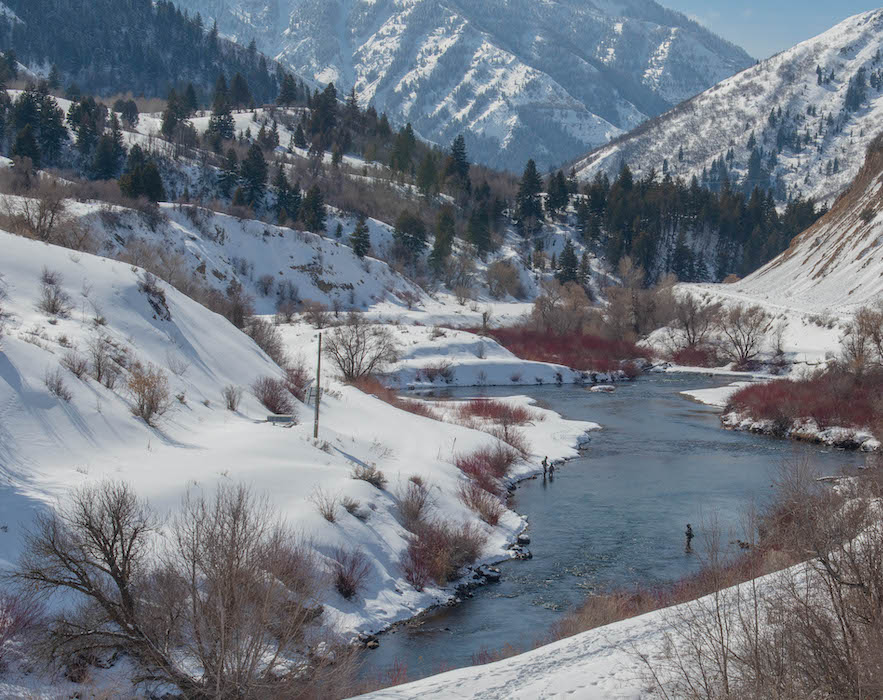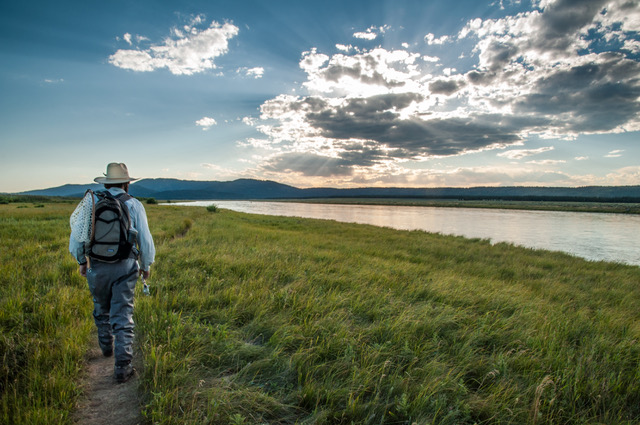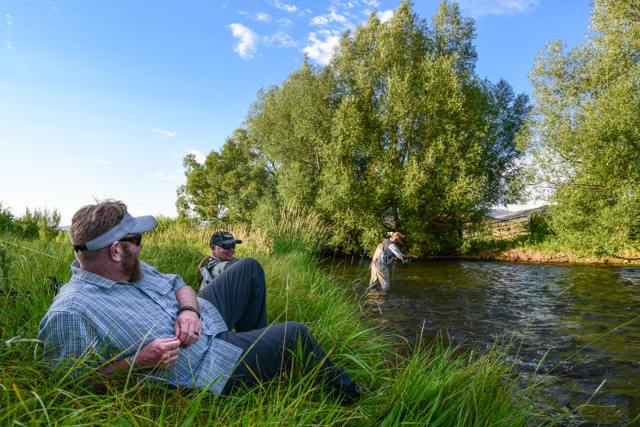Stream Etiquette
Posted by Steve on Feb 26th 2019

I pulled into the parking lot, and there was already a few more cars than I had hoped. Unfortunately, I wasn’t surprised, but had been hopeful to find some solitude and open water today.
After suiting up, I found the well worn path that parallels this fabled river and headed downstream. I hadn’t gone far before I had to make a choice: either divert my walk away from an angler near the bank a short distance below me, or hold my course and potentially impose upon his fishing.Knowing how I’d feel if I was in his situation, I moved far off the path, aware of my shadow and the effect it would have on his fish. I tried to make my presence as minimal as possible, respecting his opportunity and experience as best I could.
Once out of the “sphere of influence” I again found the trail, continuing my stroll in paradise. I didn’t get far before a rise from a decent trout stopped me in my tracks. I took time to scan the mirrored currents looking for what the rainbow was feeding on, hopefully a successive rise, and in the process got sucked into the natural rhythms of this special place. Not long after, an impetuous angler blew past me, not saying hello or bothering to ask if I had a fish up. His shadow waved across the water as he rambled on. In his haste he was oblivious to everything and everyone else he was affecting, literally leaving a wake of disturbance in his path. Needless to say, I was a little irked by his inconsiderate and impersonal demeanor, and I tried to not let it interfere with my day.
In an ideal world we’d cast a fly on our favorite river, stream, lake or reservoir without having to share it with others, except chosen company. But today, that’s simply not realistic. As we fish on the west’s more iconic waters we’re not going to catch the “good-ole days”, we’re going to run into other anglers. Depending on the time of year and what hatches are taking place, our rivers can be crowded. So, before the season gets underway, Iwant to revisit stream etiquette and have a conversation that will lead to more respect and generosity on the water.
What constitutes good stream etiquette? From a lifetime of wandering the world’s waters with a fly rod, it’s apparent that the specifics and details are different for everyone, and the gift of respect and consideration are appreciated ubiquitously. Therefore, I choose to follow a code of conduct centered on respect for others, because I want to be treated that way too.
One simple question helps boil down the nuances of etiquette: Are you having a negative impact on the experience of others around you?
For starters I’d say there is a common sense approach to stream etiquette. In general, the right-of-way on the river goes to those who were there first. Those following in their wake should yield to their wishes and not let their presence interfere or encroach upon their fishing. It's a broad approach to stream etiquette, and can vary among anglers and from river to river. Hopefully by the time you finish with this piece, you’ll have some tools to help you navigate through the nuances of good stream-side behavior.

For those new to the game of fly-fishing you may ask: how do you know when you’re encroaching, or impacting someone’s fishing in a negative way? Initially, if you are questioning whether your presence is affecting a fellow angler, you probably are. If you pay close attention, you’ll probably pick it up in their body language. However, if you are uncertain this can often be cleared up by engaging those you may be impacting with a brief conversation to discuss intentions and your possible impact on them.
I brought this topic up with my shop and morning coffee crew. They felt that good stream etiquette comes from: observation and asking if your fishing would impact the experience of others. With observation, consideration, discussion, and a respect for other anglers desires, the best next move becomes clear.For example, if you’re wanting to fish a sizable piece of water where someone else is fishing and you feel there may be sufficient room to jump in, you shouldn’t assume that is the case. Usually, just jumping in isn’t a good idea. Get a sense of where they are fishing and more importantly where they are going. Are they moving through the area, or staying in one place? Pay attention, slow down, and be considerate of their experience. If you’re unsure, talk to them. Try not to interrupt their fishing and wait until a break occurs to start a conversation. Then check in to see how they’re doing, what their spatial needs are, fishing plans, and if they are ok sharing some water.
Kigen, our head-guide at the shop, suggests having an open mind to these interactions. In other words, be equally ready for either a “Yes, you can fish there” or a “No, that wouldn’t be cool”. If the answer is “no”, move on and thank them for the consideration. A different piece of water may end up teaching you something new. We are habitual creatures, but we can look at this as an opportunity to change our habits and grow as anglers.
In general, if an angler appears to be working their way upstream, don’t jump in at the head of the run even if there appears to be room. That angler may have plans to continue upstream for some distance. This is a common practice for those fishing dry flies, while prospecting for a willing taker. Should you choose to jump in ahead of someone, this is commonly referred to as high-holing, or simply cutting them off. The same goes for anglers moving downstream. Those who fish streamers or swing soft hackles work through a run in this manner. Be conscientious that many anglers are not planning to stand in the same place while fishing. If you’re not sure on how to proceed, take a minute to observe, then ask if necessary. We feel this is a good way to operate, meet people and get a sense for what’s acceptable on a given piece of water, especially one you’re not familiar with.
Beyond direct interactions, on-stream behavior can impact all anglers for the day, especially those pursuing fish with dry flies. As you move up or down a stream, walking too close to the river, casting a shadow on the water, or wading aggressively can put fish down, especially larger trout. This will make fishing more difficult for the angler next in line or even for yourself.
Finally, another common sense approach my crew came up with is having realistic expectations. My story that prefaced this piece is an example of this. I understood it was a busy time of year to be on this particular river and I was late in arriving. Since I was quite familiar with this fishery, I knew there was a good chance that I would run into an angler or two and some of them might rub me the wrong way. As I looked for a place to fish or for rising fish that would be worthy targets, I realized I needed to pay attention so I didn’t interfere with those who had arrived before me. I also may learn something by slowing down; paying attention to others and the river. Being realistic about my expectations helped temper my day, and ensured I wouldn’t affect others or be impacted by those who might ruffle my feathers. Of course, you have to know a river to be able to set the table and for those new to fly-fishing, this can be a challenge, and is one we’ve all been faced with.
So as you head out the door, here are some ideas to consider regardless of how long you’ve been casting a fly.
- Be observant:
- As you head streamside, pay attention to others as you make your way.
- Pay attention to body language when you approach someone. It may tell you all you need to know about how you are affecting them.
- Be considerate:
- Realize as you walk along, that your presence will impact fish, especially feeding fish if you walk too close to the edge of the water. If you encounter another angler, be prepared to yield a wide berth.
- If you come across other anglers, take note of where they’re fishing or likely to fish before approaching, or moving past them.
- Manage your own expectations, you aren’t the only one out there fishing
- If it’s a crowded day and you’ve had a chance to catch a number of fish from a piece of water, let someone else try their hand. Go explore some new water, and broaden your horizons.
- Don’t race others to a piece of water.
- Don’t sit on top of someone while they’re fishing a piece of water you’d like to fish. Move on, go exploring.
- If in doubt, ask!
- If you’re not sure of a situation, ask. Don’t assume. Before stepping into the water, make sure your not walking in on someone else.

What we all have in common, is we all want to enjoy fishing and to catch a fish or two. Fortunately for us here in Utah, and the west we have some great options out our back door. We also, on most occasions, will have to share our waters with others. Especially since recent fires may limit our fishing opportunities in upcoming years. Personally sharing can make for a better experience and the more we respect others’ opportunities to enjoy the water, the better all of our fly-fishing experiences will be. On a given day, that may lead to catching a few less fish, but I’ll take an enjoyable experience over notching my belt any day. Hopefully, as the owner of Western Rivers, my crew and I set good examples as stewards of waters that we have the good fortune of sharing with you.
So, as we head out this year, let’s all try to do a better job of sharing what we are fortunate to have. Lets cut each other a wide berth as we navigate our waters, and be gracious in doing so. It will make our days on the water more rewarding and preserve the experience as we cast our flies on waters we love.


